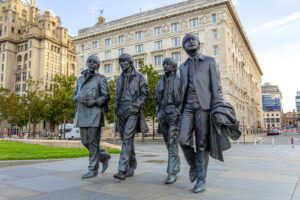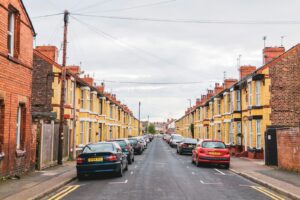Bringing local start ups to the high street

The Made in Stirling shop in Stirling city centre
Using empty shops as the platform for local entrepreneurs to test their ideas, Start Up Street Stirling is re-invigorating its town centre from within, as Diarmaid Lawlor reports
Finally, the sign went up. It was real. ‘Made in Stirling’, the first shop delivered as a collaboration between Start Up Street and the Stirling Creative Industries Forum, was ready.
Inside, the shop is stocked with the products of people who live in the area. Handmade art, graphic design services, fashion, and pieces of sculpture rest on the shelves. Nearly twenty creatives will exhibit or sell from the shop. Their presence visualises a talent in a city, a city whose story is often hard to see at first: a lot is hidden. The shop sign does more than announce a shop. It confirms the presence of action for change.
‘Excellent! Action on the ground!’, says city centre manager Andy Kennedy summing up his feeling at the opening of Made in Stirling. Kennedy is a change-maker. His belief is that the change needed for town centres won’t happen by tinkering. We need to get below the skin of the town and the problems they face. This means a new way of engaging with people to shape solutions.
Start Up Street helps start up businesses to test their ideas in a supportive community context by re-using vacant spaces in the city. It is a bit like combining the ideas of ‘try before you buy’ with co-working, the idea of a Hub on a street. The aim is to support an entrepreneurial culture by providing a platform for the citizens of the city with all of their talents to try out their ideas and foster a community of change.
‘BAKING’ NEW IDEAS FOR DECLINING URBAN CENTRES
Start Up Street is a response to a decline in the city centre of Stirling. In 2008 a City Centre Healthcheck identified that vacancies were on the rise, particularly in King Street, and that there were issues with pedestrian numbers, patterns of use and perceptions of safety. Stirling is a medieval city in a stunning landscape setting. However, Open for Business, the economic strategy, identified poverty and lack of positive destinations as challenges, as well as a need to change the city centre offer.
In response to a city visioning exercise for the local development plan, it was decided to host an Urban Ideas Bakery in the city centre with the British Council as part of their ‘Creative Cities’ initiative. The Urban Ideas Bakery is a participatory, co-design process, whose aim is to create deliverable scaleable and impact-oriented projects with and for people.
 In Stirling, the city centre manager hosted the event through the economic partnership, and it was phenomenal. It was different. It engaged people in a new way.
In Stirling, the city centre manager hosted the event through the economic partnership, and it was phenomenal. It was different. It engaged people in a new way.
Designed by Ted Matthews, international service designer, chaired by Karen Houghton, an urban visionary and facilitated by ‘bakers’ from all over Europe, it brought together nearly 50 people from the city centre for three days to develop solutions. Underpinning this work was a service design diagnostics, which unpacked the city centre in terms of the core issues, who it affects, what the effects are and the costs in social, economic, cultural and environmental terms. This rigour in unpacking the problem was important in that the focus for action was owned by all.

IDENTIFYING THE CITY’S ASSETS
On the first day, Norrie, a youth officer from the council, talked about an arts project where young people in community centres created a film of their journey through the city. They scripted, filmed, edited, made the music and overlaid the production with an animation. It was an excellent product. What was sad, though, was that many had no path to develop their skills, and wouldn’t.
Michael from the youth service was fantastic. He is just twenty and goes about the city talking to his peers, building chances for them. He could be anywhere else in the world, doing anything else. He isn’t. He is here. He is an asset. This was the main finding of the Bakery, a means of identifying the actual asset base of the city, and a need to construct pathways for people to do what they want to do. Four key actions were identified: a process of on-street engagement; street blogging; a series of off-piste city tours to show the hidden story of the place; and a framework to connect people and spaces to innovate. ‘Start Up Street’ was born.
We Are Snook, a young innovative service design collective from Glasgow were commissioned to develop up the idea. The development started by re-engaging with the people of the city, seeking to understand what kind of ventures they might be interested in starting, and how they might collaborate. This was a formalised asset-mapping exercise. The purpose of the exercise was to understand how a user might come into contact with the service, and what might be needed to support this user in their journey to making their idea happen. The reason we started here is to do with sustainability. An initial prototype was tested in 2011, resulting in a second service design prototype which is being tested through the ‘Made in Stirling’ shop.
CREATING A COMMUNITY
‘Made in Stirling’ pulls together a lot of action in the city in the last few years. It pulls together research on creative industries by the council, it collaborates with a new energy established by the Stirling Creative Industries Forum, and a new social enterprise, Creative Stirling, established by the energetic Joe Hall. This is a city where there are things happening, and young people are contributing, a lot. Icecream architecture, a young and innovative Scottish design practice, worked with Joelle from the business support service of Stirling Council, to secure the temporary lease for ‘Made in Stirling’.
Joelle, Sarah and Des threw themselves enthusiastically into the project of realising and managing a working shop. Local businesses helped with the refurbishment and fit out. An open call went out to the city for people to be part of the business of the shop. Demand outstrips supply. The prototype is being tested. The learning being gathered by Snook will ensure that Start Up Street is sustainable and gives people a fair chance to develop their ideas, their way.
 In the initial prototype, a key concern was about the idea of Start Up Street as a community. How do you seed this, help make it happen? Every shelf in Made in Stirling was made by Steven, one of the creative exhibitors. Staci and Paul, local graphic designers, did all the promotional material and branding. The shopkeeper next door holds the key. On the opening night, songwriters and local musicians wanted to be part of the initiative. It was the most humbling thing to realise that the city wants to support people giving it a go. There is love, passion, and trust. That seems to be the answer to the design problem about community. That’s the future for Start Up Street.
In the initial prototype, a key concern was about the idea of Start Up Street as a community. How do you seed this, help make it happen? Every shelf in Made in Stirling was made by Steven, one of the creative exhibitors. Staci and Paul, local graphic designers, did all the promotional material and branding. The shopkeeper next door holds the key. On the opening night, songwriters and local musicians wanted to be part of the initiative. It was the most humbling thing to realise that the city wants to support people giving it a go. There is love, passion, and trust. That seems to be the answer to the design problem about community. That’s the future for Start Up Street.
- Find out more about Start Up Street Stirling here















